The Shibusawa 1909 Delegation is welcomed by the City of Ithaca.
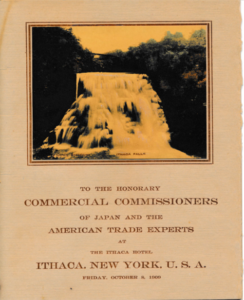
Front cover to a celebratory Event Program/Dinner Menu (six page brochure) honoring the visit of Baron Eiichi Shibusawa & his wife, and his accompanying Japanese goodwill/business delegation.
The description reads:
“To The Honorary COMMERCIAL COMMISSIONERS of Japan and the American Trade Experts at the Ithaca Hotel, Ithaca, New York. U.S.A. Friday, October 8, 1909” – (Photo of beautiful Ithaca Falls.)
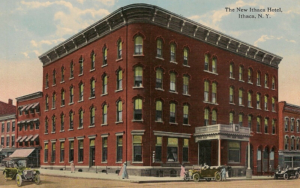
1909 Postcard of The Ithaca Hotel, where the event occurred.
Background History on Baron Shibusawa and his 1909 delegation:
Baron Shibusawa is known as the “Father of Japanese capitalism” and frequently referred to as the “Japanese J. P. Morgan.” An industrialist and entrepreneur, he was responsible for introducing Western-style capitalism to Japan during the Emperor Meiji period (1868-1912). With financial interests in railroads, steel, printing, gas, electric, mining, fishing, and oil, Shibusawa quickly became Japan’s wealthiest man. During his long life, Shibusawa helped launch over 500 companies, and was responsible for modernizing Japan’s economic and banking systems, including the introduction of paper notes. At one time, he was the director of seventy companies, however, he resisted direct ownership/control of most of the companies he helped launch, preferring an advisory role instead, giving more freedom for these new companies to determine their own strategies for growth.
Shibusawa founded the Japanese Chamber of Commerce and Industry and the First National Bank of Japan – and for two decades, he was the chairman of the Tokyo Chamber of Commerce. His priorities went beyond pure profit, when referring to his business ventures, he called it stakeholder capitalism (rather than traditional capitalism). He felt strongly that the growth of a nation, economically and otherwise, depended on the involvement of many stakeholders. While profit was still a significant goal, he often integrated ethical beliefs, and even Confucianism, into his management practices. Beyond his business interests, he utilized his own funds to establish over 600 organizations aimed at social welfare, including hospitals, universities, and disaster relief programs among others.
At the start of the twentieth century, U.S. – Japanese relations reached a new stage, with Japan emerging as an economic powerhouse in the Pacific, combined with its growing military. To ease potential tensions between the two countries and also increase business/financial relations between their nations, a delegation of U.S. businessmen were invited to visit Japan in 1908. This invitation was sent to representatives of the Associated Chambers of Commerce of the Pacific Coast. This invitation came from the chambers of commerce of six major cities of Japan: Tokyo, Yokohama, Osaka, Kyoto, Kobe, and Nagoya. Their invitation was accepted, and approximately sixty U.S. representatives made a tour of Japan, where they were received with generous and even lavish hospitality, not only by the people, but also by the imperial government. Prince Iyesato Tokugawa and Baron Eiichi Shibusawa were central figures in receiving this U.S. delegation.
-In appreciation for the fine cordiality shown to the U.S. delegation during their 1908 visit to Japan, an invitation in 1909 was now sent to the Japanese to tour the U.S. This invitation came from the Associated Chambers of Commerce of the Pacific Coast, whose membership included the chambers of commerce of eight principle cities: San Francisco, Los Angeles, San Diego and Oakland in California, and Seattle, Tacoma, Portland, and Spokane in the Northwest.
Based on this pleasant invitation, in 1909, Baron Shibusawa headed a Japanese delegation to the U.S., which included many of Japan’s most prominent business leaders and notables. They sailed from Yokohama, on August 19, on the American steamship Minnesota, and arrived first in Seattle, Washington, on Wednesday, Sept. 1st. They left Seattle on Sept. 6th, and began their journey visiting 53 cities from the West coast to Boston, and returning from New York back to Los Angeles and then to San Francisco.
Of the fifty-eight members in this Japanese delegation, six were women (five of them the wives of the commissioners), thirteen private secretaries, and thirty-nine commissioners. They would travel 11, 000 miles thru-out the U.S. before returning home. This delegation included nine members of the Japanese parliament, two of the largest banking houses were represented by Baron Shibusawa, and the bank of Mitsui & Co. represented by Kenzo Iwahara, Managing Director. There were six other bankers in the group, and also representatives of nearly every line of industry and commerce, including the ownership and management of electric railways, shipbuilding, manufacturing of silk and cotton, exporting and importing, and stock market brokerage – The professions of law and medicine were also represented, as well as some well-known Japanese educators, authors, and newspaper writers.
Their main goals were to develop friendship between the two nations while encouraging bilateral trade and commerce. This sentiment was repeatedly expressed by Shibusawa and other commission members, as well as by their American hosts. The delegation made the news across the United States, during the course of their three month journey. They traveled in a specially outfitted ‘Million Dollar Train,’ provided by the American industrial community. Their meetings included many chambers of commerce. There were also tours of factories, power plants, fire departments, port facilities, mines, farms, schools, universities, libraries, theaters, churches, hospitals, and many other facilities.
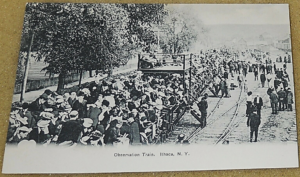
1909 – Ithaca, New York – Raised observation platform with a crowd gathered awaiting a Train’s arrival – This postcard gives a sense of the welcoming reception given for the Japanese Delegation.
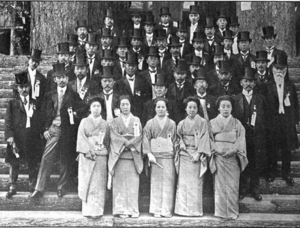
November 1909 photo from The Coast magazine (Seattle, Washington).
Baron and Baroness Shibusawa (front center), with the other Japanese delegates and their wives, pose at the Forestry Building at the Alaska-Yukon-Pacific Exposition. The delegation included bankers, presidents of the chambers of commerce from the largest cities in Japan, businessmen who were members of the Japanese Diet (Japanese Congress), and several Japanese consuls general, who were stationed in the United States. Delegates included representatives of the Tokyo Stock Exchange, lawyers, publishers, journalists, as well as a university professor and a physician. (Note: The Alaska-Yukon-Pacific Exposition was a world’s fair held in Seattle, Washington, publicizing the development of the Pacific Northwest. The fairgrounds became the campus of the University of Washington.) The Japanese delegation’s trip was arranged by Asahi, one of the largest newspapers in Japan (which is currently known as The Asahi Shimbun (朝日新聞).
At the train station in the City of Ithaca, a large reception was given for their honored Japanese visitors – This greeting party included the city’s current Mayor and nine former Mayors. Also attending were five former Presidents of the Village of Ithaca, as well as representatives of Cornell University, including Dean Charles H. Hull, members of his staff, along with eight Cornell professors. Also there to respectfully receive them were the student president and members of the Japanese Club of Cornell. The Ithaca Business Men’s Association, along with many others attended, as displayed in the Menu/Program.
To make the visitors’ experience in the U.S. more enjoyable, six members of the Associated Chambers of Commerce volunteered to accompany their Japanese friends/business colleagues, to assist in managing the events along their journey. Those six individuals are also highlighted within the Menu/Program.
In addition to the above, the U.S. government recognized the international significance of this Japanese visit and sent three U.S. representatives to accompany and be of assistance during their travels.
During their time in the U.S., they were greeted by many distinguished American leaders including President William Howard Taft, whom Baron Shibusawa and Prince Tokugawa had already befriended years earlier, when Taft had served as minister of war, under President Theodore Roosevelt.
Shibusawa and his delegation were also greeted by the inventor Thomas Alva Edison of General Electric, and James Jerome Hill of Great Northern Railway. When their continental journey ended, they left San Francisco on November 30, traveling to Honolulu, Hawaii, then arriving in Japan on December 17, 1909. With them, they carried fresh information on a wide range of industries, as well as many new cultural insights.
The stated goals of the Japanese delegation were:
-To increase and extend trade relations between the U.S. and Japan
-Improve personal acquaintances and friendly relations between representatives of both nations.
*It is significant to note that the U.S. Chamber of Commerce was founded in 1912, just three years after the 1909 visit of the Shibusawa delegation – It is most likely that this highly publicized Japanese business visit served as a catalyst connecting chambers of commerce across America into becoming a national organization. President Taft was one of the U.S. leaders that Shibusawa met with during his visit, and Taft is recognized as one of those who encouraged the establishment of the U.S. Chamber of Commerce, to support and enhance the economy of the United States.
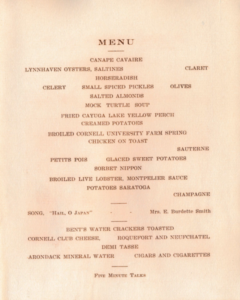
A lavish meal, followed by Five Minute Talks – This illustration and the four that follow are part of the Event Program/Dinner Menu brochure presented earlier.
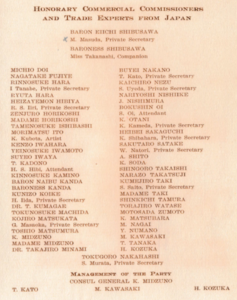
Japanese Delegates, along with those who managed the Party. This list is also presented with additional information in Note [1]
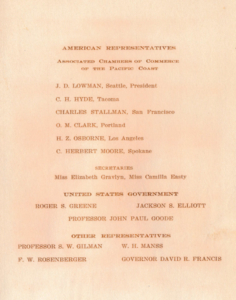
American Representatives attending the event. This list is also presented with additional information in Note [2]
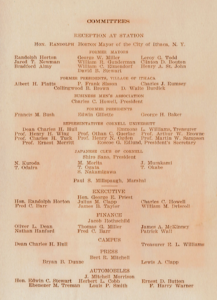
Committee Members – This list of notable citizens of Ithaca, is also presented with additional information in the Notes [3]
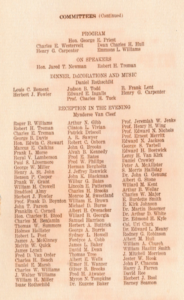
Committee Members (continued) the notable civic and business leaders of the Ithaca community, who put the Program together, were Speakers, arranged the Dinner, Decorations, and Music, and were part of the Evening Reception. *See Note [4] for more info about the two prominent speakers Robert H. Treman and Jared T. Newman
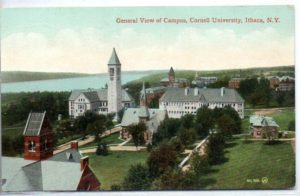
View of Cornell University – Ithaca, N.Y. – 1909 Postcard
Below is the top segment of a newspaper article that gave an overview of the Japanese delegates’ three month tour and also highlighted the hospitality they had received in the city of Buffalo, New York, three days prior to their reception in Ithaca. [The Buffalo Commercial – 05 Oct. 1909, Tue • Page 1]
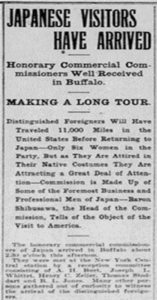
– The Shibusawa Eiichi Memorial Foundation / Museum (located in Japan) honors and preserves the legacy of Baron Shibusawa and his allies – Their website is: https://www.shibusawa.or.jp/english/museum/
The Honorary COMMERCIAL COMMISSIONERS of Japan felt so appreciative for the fine treatment they had received during their visit, that when they returned to Japan, they sent back a gift to the U.S.A..
It was given to a representative of Northwestern New York State, F. W. Rosenberger, Esq., a member of the City of Buffalo, New York Chamber of Commerce. He was also one of the U.S. representatives who attended the above event in Ithaca, New York. It is a Japanese silver two handled presentation cup on a square pedestal inscribed in Japanese on the base on one side, and in English on the other side, as shown in the below photos.



Decorated with Japanese dragon emblems around the top rim and an American eagle symbol in the circular area between them.
The English inscription reads:
Presented to F W Rosenberger, Esq. by the honorary commercial commissioners of Japan to U.S.A. 1909.
Marked Tamonten Tokio and signed in Japanese.
Meiji period. Height 5 1/2″ Length 8″. Weight 28.25 troy oz.
This silver trophy was sent as a return gift from “The Honorary Commercial Commissioners of Japan to the U.S.A” (渡米実業団) to the people who took care of them.
The Japanese writing on the base of the above silver gift lists the names of many of the Japanese visitors who toured the U.S.A.
Further information about this gift is available in Note 5 in the Notes Section at the end of this blog post.
*The historical content for this article was discovered while researching for an illustrated biography.
This biography comes in two versions: The Art of Diplomacy and The Art of Peace. Both highlight the Japanese international statesmen Prince Iyesato Tokugawa (aka Prince Tokugawa Iesato) and his allies, such as Baron Eiichi Shibusawa – These true humanitarians devoted their lives to creatively promoting peaceful international relations, a prosperous global economy, and democracy – Two decades of historical research was combined with the discovery of hundreds of rare illustrations, to reveal many significant unknown events that shaped the destinies of the United States and Japan.
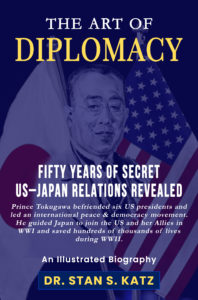
PRINT & KINDLE EDITION
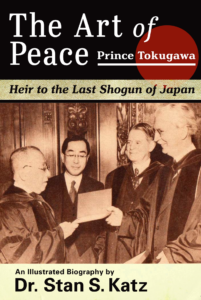
DIGITAL EBOOK EDITION [includes an additional 100 pages of historical notes to assist researchers]
NOTES FOR THIS BLOG POST
Note 1 –
List of the 1909 Japanese Delegates:
Baron Eiichi Shibusawa
M. Masuda, Private Secretary
Baroness Shibusawa
Miss Takanashi, Companion (niece of Baron and Baroness Shibusawa)
Michio Doi
Nagatake Fujiye
Rinnosuke Hara
I. Tanabe, Private Secretary
Ryuta Hara
Heizayemon Hibiya
R. S. Iiri, Private Secretary
Zenjuro Horikoshi
Madame Horikoshi
Tamenosuke Ishibashi
Morimatsu Ito
K. Kubota, Artist
Kenzo Iwahara
Yeinosuke Iwamoto
Suyeo Iwaya
T. Kadono
H. S. Hibi, Attendant
Kinnosuke Kamino
Baron Naibu Kanda
Baroness Kanda
Kunizo Koike
H. Iida, Private Secretary
Dr. T. Kumagae
Tokunosuke Machida
Kojiro Matsukata
G. Masaoka, Private Secretary
Toshio Matsumura
K. Midzuno Consul General
Madame Midzuno
Dr. Takajiro Minami
Buyei Nakano
T. Kato, Private Secretary
Kaichiro Nezu
S. Uyeda, Private Secretary
Nariyoshi Nishiike
J. Nishimura
Bokushin Oi
S. Oi. Attendant
K. Otani
K. Kameda, Private Secretary
Heibei Sakaguchi
K. Shibahara, Private Secretary
Sakutaro Satake
W. Natori, Private Secretary
A. Shito
K. Soda
Shingoro Takaishi
Narazo Takatsuji
Kumejiro Taki
S. Saito, Private Secretary
Madame Taki
Shinkichi Tamura
Torajiro Watase
Motosada Zumoto – also accompanied Baron Shibusawa when he returned to the U.S. in 1915, and a banquet was held to honor him. This 1915 diplomatic event attended by former Presidents Theodore Roosevelt & William Howard Taft – A PHOTO of that diplomatic gathering is presented as part of another Blog post on TheEmperorAndTheSpy.com) – M. Zumoto served as the translator and secretary for Baron Shibusawa – He was also a part owner and editor of The Japan Times – Japan’s largest and oldest English-language daily newspaper, currently published by The Japan Times, Ltd. (株式会社ジャパンタイムズ) of Tokyo. In addition, M. Zumoto was the Director of the Oriental Information Agency of New York.
K. Matsubara
M. Nagai
Y. Numano
M. Kawasaki
T. Tanaka
H. Kozuka
Tokugoro Nakahashi
S. Murata, Private Secretary
Names of those who managed the 1909 event in Ithaca, New York
Consul General K. Midzuno (Consul General Midzuno also in a 1915 photo when Baron Shibusawa visited the U.S. again and a banquet was held to honor him, which was attended by former President Theodore Roosevelt and William Howard Taft). A PHOTOGRAPH of that event is presented as a Blog post on the website: TheEmperorAndTheSpy.com). Consul General Midzuno is one of the Japanese officials linked to the Japanese gifting of the cherry blossom trees to the U.S. Capital in 1910 and 1912.
T. Kato
M. Kawasaki
H. Kozuka
Note 2 –
American Representatives at the 1909 Ithaca event
Associated Chambers of Commerce of the Pacific Coast
J. D. Lowman, Seattle, President
C. H. Hyde, Tacoma
Charles Stallman, San Francisco
O. M. Clark, Portland
H. Z. Osborne, Los Angeles
C. Herbert Moore, Spokane
Secretaries
Miss Elizabeth Gavlyn,
Miss Camilla Easty
U.S. Government
Roger S. Greene – State Department
Jackson S. Elliott – from Washington, D.C., representing Associated Press for the U.S. Dept. of Commerce and Labor
Professor John Paul Goode – University of Chicago
Other U.S. Representatives
Professor S. W. Gilman – from the University of Wisconsin, representing the cities of Minneapolis and St. Paul, Milwaukee, and Duluth.
F. W. Rosenberger – from the city of Buffalo, he represented the Northwestern New York.
W. H. Manes – of the Chicago Association of Commerce, represents the cities of Chicago, Des Moines, and Omaha.
Governor David Rowland Francis (October 1, 1850 – January 15, 1927) was an American politician and diplomat. He served in various positions including Mayor of St. Louis, the 27th Governor of Missouri, and United States Secretary of the Interior. He was the U.S. Ambassador to Russia between 1916 and 1917, during the Russian Revolution of 1917. He was a Wilsonian Democrat. After graduating from University, David R. Francis became a successful businessman in St. Louis and served as the president of a grain merchant’s exchange. The St. Louis Mining and Stock Exchange was formed in St. Louis in the fall of 1880 with Francis as a founding member. Source: Wikipedia.
Note 3–
Below is a transcription of the names of the Committee Members for the 1909 event:
Reception at Train Station
Honorable Randolph Horton Mayor of the City of Ithaca, N.Y.
Former Mayors:
Jared T. Newman
Bradford Almy
George W. Miller
William R. Gunderman
William C. Elmendorf
David B. Stewart
Leroy G. Todd
Clinton D. Bouton
Henry A. St. John
Former Presidents of the Village of Ithaca:
Albert H. Platts
P. Frank Sisson
Charles J. Rumsey
Collingwood B. Brown
D. Waite Burdick
Business Men’s Association:
Charles C. Howell, President
Former Presidents:
Francis M. Bush
Edwin Gillette
George H. Baker
Representatives of Cornell University:
Dean Charles H. Hull
Emmons L. Williams, Treasurer
Professor Henry H. Wing
Professor Othan C. Guerlac
Professor Arthur W. Browne
Professor Charles H. Tuck
Professor Charles H. Tuck
Professor Henry N. Ogden
Professor Martin W. Sampson
Professor Ernest Merritt
Roscoe G. Edlund, President’s Secretary
Japanese Club of Cornell:
Shiro Sano, President
N. Kuroda
T. Odaira
M. Morita
T. Ogata
S. Nakamigawa
J. Murakami
T. Okabe
Marshal: Paul S. Millspaugh
Executive:
Honorable George E. Priest
Honorable Randolph Horton
Julius M. Clapp
James B. Taylor
Charles C. Howell
William M. Driscoll
Finance
Jacob Rothschild
Oliver L. Dean
Nathan Hanford
Thomas G. Miller
Fred C. Barr
James A. McKinney
Patrick Wall
Cornell University Campus:
Dean Charles H. Hull
Treasurer E. L. Williams
Press:
Bert R. Mitchell
Bryan B Dunne
Lewis A. Clapp
Automobiles to pick up visitors:
J. Mitchell Morrison
Honorable Edwin C. Stewart
Herbert L. Cobb Earnest D. Button
Ebenezer M. Treman
Louis P. Smith
F. Harry Warner
Ernest D. Button
Note 4- Robert Henry Treman (1858-1937) was one of the two speakers at the 1909 event honoring the visit of the Shibusawa Delegation.
Based on the author of this article’s enthusiasm for nature and his prior visits to beautiful upstate New York, here is some additional information about Robert Henry Treman, who was an amazing environmentalist and nature lover: Treman was born into an influential Ithaca family in 1858. He attended local schools and Cornell University and joined the family hardware business in Ithaca in 1878. During his association it grew from a small local business to a large corporation. His family also owned an iron foundry, and they had controlling interests in the Tompkins County Bank, the Ithaca Gas Light Company, and the Ithaca Water Works. The Treman family acquired land around Buttermilk Falls and other creeks in case they needed to tap the water for their company. In 1891 he was elected director of a local bank and in 1932 became Chairman of what was eventually known as the Tompkins County Trust Company. He was also a director of the Federal Reserve Bank of New York from 1913 to 1931.
In 1891, Treman also became a trustee of Cornell University, a post he held for 45 years. He worked with fellow trustee Henry Sackett to improve the Cascadilla and Fall Creek glens near the Cornell campus. This period after the Civil War was a time of increasing awareness of the America’s natural environment. The Trustees of Reservations was established in Massachusetts in 1891 to protect the natural environment in that state. California quickly followed suit. By the 1920s the American Scenic and Historic Preservation Society had become prominent. A movement to establish state parks grew up, encouraged by the increased interest in automobile touring.
About 1915, as Treman was bringing friends to visit the Enfield gorge — a well-known Ithaca scenic destination — he noted the decline in the hamlet of Enfield Falls. Remembering his family association from his childhood days, he made arrangements to buy the mill as well as the miller’s house. He closed the mill, which was still operating, temporarily. During World War I, Treman and his wife Laura continued to buy properties in the area. In 1920, when most of the property in the hamlet of Enfield Falls had been acquired, Robert and Laura donated the land to New York State to establish a state park to be called Enfield Glen Reservation. Treman was chairman of the Enfield Falls Reservation Commission from 1920 to 1924. He also donated land, which had been acquired as a possible water source for the city of Ithaca, along Buttermilk Creek to create another park in 1923. He then continued to serve as Chairman of the Finger Lakes Commission, which also oversaw other parks in the area, from 1924 until his death in 1937.
[Source of the above biographical info: The Friends of Robert H. Treman State Park, chartered thru the State Education Department of the State of New York. Its purpose is to conduct educational and history-related programs, services, and activities in keeping with the nature of the park, to assist in fund raising activities, the purchase of objects, equipment, and supplies for the benefit of the park, and to support this park for the benefit of the local community, the residents of the State of New York, and the general public.]
– Jared Treman Newman – the other listed speaker at the 1909 event honoring the visit of the Shibusawa Delegation – Jared Treman Newman was an Ithaca, New York attorney, 1893-1896, and Mayor, 1907-1908; Cornell University Trustee, 1895-1903 and 1907-1933; and a bank official. Cornell University Class of 1875.
NOTE 5
Further details about the silver gift given by the Honorary Commercial Commissioners are as follows: Its photo appears on the gravure page of the following book, and the circumstances are described on page 627 of the following book.
渡米實業團誌 | WorldCat.org
https://search.worldcat.org/en/title/1020991311
渡米實業圃誌 – Tobei Jitsugyōdan – Google ブックス
https://books.google.co.jp/books?id=HBOlWY_1Q30C
Parts of this book is cited in “Shibusawa Eiichi Denki Shiryo,” which states that Rosenberger was a member of the Buffalo Chamber of Commerce and served as the Northwest New York State representative when accepting the Honorary Commercial Commissioners of Japan.
第32巻(DK320013k)本文|デジタル版『渋沢栄一伝記資料』|渋沢栄一|公益財団法人渋沢栄一記念財団
https://eiichi.shibusawa.or.jp/denkishiryo/digital/main/index.php?DK320013k_text#DK320013k-0005
紐育州西北部代表者(バッファロー商業会議所会員)
エフ・ダブリュー・ローゼンバァガー殿

Leave a Reply